19 Actionable Tips To Drive Website Traffic 


Are new customers finding you online? You can’t just build a website and expect customers to come running.
Optimising your website and investing in digital marketing is essential to attract more of the right crowd.
But with so much noise online, how do you know which techniques will actually work?
Maybe you’ve already invested some time in optimising your website and found that the techniques you’ve tried have produced poor results.
Eventually, you give up. But that’s the wrong choice. With the right strategy, you could:
- Boost traffic by as much as 600%
- Double your leads
- Increase conversions by 300% or more.
So, what’s the secret?
It’s not about what you do.
Everybody’s singing from the same hymn sheet when it comes to the “what”.
It’s all about HOW you do it.
The “how” is the missing ingredient to generating traffic and getting more leads. If you don’t know how, you don’t get results.
You’ve probably heard about what you need to do before:
- Content marketing gets people to engage with your site.
- Search engine optimisation (SEO) raises your rankings in search engine results and boosts lead generation.
- Pay-per-click (PPC) advertising drives site traffic.
You know this.
But none of that matters if you don’t know how to use these techniques properly. Poor execution limits business growth.
Your goal is to generate a steady stream of qualified traffic. That’s the best way to secure long term revenue growth.
What is the best way to drive more website visitors? Let’s take a look at how to do it properly, using both organic and paid methods:
- Make SEO the priority
- Nail your keyword research
- Craft content for every stage of your funnel
- Optimise your on-page elements
- Build high-quality backlinks
- Don’t forget about internal links
- Track and analyse your SEO performance using SEO tools
- Socialise online
- Use the right social media platform for your audience
- Answer questions on Quora
- Leverage influencer marketing
- Participate in Facebook Group discussions
- Don’t forget about email marketing
- Drum up referral traffic with guest posts
- Build linkable resource lists
- Get in front of your target audience with search ads
- Integrate your PPC advertising across social media
- Steal your competitor’s strategy
- Use PPC ads to inform other marketing channels
Get ready to drive website traffic fast with these strategies:
1. Make SEO the priority
Unless your business is the result of a ground-breaking idea that nobody has ever thought of before, there’s a good chance that you have a bit of competition already out there.
This is where Search Engine Optimisation comes into play.
Good SEO puts you in front of the right people – people who are already searching for what you have to offer.
If you were ever in doubt about the power of SEO, this SEO stat is for you:
Organic and local search is responsible for 73% of all page views, compared with 9.4% for referral traffic and 8% for paid search. (Source: Milestone)
Fact is, search engine optimisation is how you build awareness of your brand and get it in front of the right people – those who will become your future customers.
The best way to think of SEO is as a long-term strategy for driving more traffic to your website, leading to an increase in conversion rates and ultimately sales.
Consider this: 69% of marketers invested in SEO in 2021. If you’re not doing the same, you’re well and truly in the minority.
2. Nail your keyword research
While we’re on the topic of SEO, let’s talk about keywords.
Keywords are the backbone of any effective SEO strategy.
Rank for relevant keywords, and you’ll put your website in the fast lane to more qualified site visitors from organic search.
Over time, this adds up to a ton of free traffic — provided you’re showing up the right search terms.
If you needed any more proof, consider this: 75% of ALL website clicks go to the top three organic results in Google search.
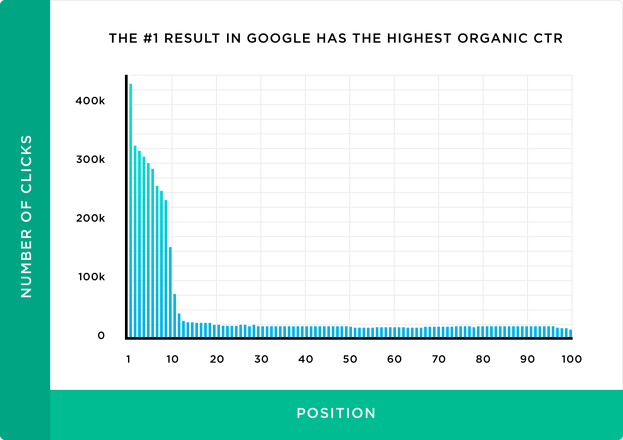
Image credit: Backlinko
When it comes to key phrase research, you want to find your golden goose: keywords that are relevant to your business, have a high search volume, low competition.
Start by brainstorming relevant topics and top-level keywords related to your business. These will form the basis of your research and your content pillars.
For example, if you’re selling beauty products online, one topic might be ‘skin care’. Keep your list to 3-5 high-level topics, which will inform the next part of your research.
After this, use a tool to find relevant phrases that people are searching for. Here are a few to get you started:
Don’t forget to include long-tail keywords (keywords with 3+ words) into the mix, as they make up 92% of all search traffic.
Of course, you can’t focus on ALL the keywords. So once you’ve put together a list of all the relevant keywords you could find, narrow them down.
Focus on aligning your search intent with your goals: for example, if you’re selling products online, look for commercial-based keywords with the words “buy” or “shop”.
Try to also keep an eye on the level of competition, search volume and keyword difficulty — you can get all of this information in your keyword research tool.
Repeat this process regularly, as search trends and keywords evolve over time.
3. Craft content for every stage of the funnel
Great content boosts results at all stages of the funnel. And in particular, it’s insanely handy to engage people when they first start searching.
Put it this way: Google demands useful and relevant results for its searchers. Your content provides this.
The more useful and relevant your content, the better your site will rank on search engine results pages.
The reverse is true, too. Poor content turns readers off from your site and also sends warning signs to search engines. If Google sees that people aren’t engaging with your content and getting what they need, it ranks your pages lower.
So, what’s the best approach for content?
Create content for each stage of the buyer’s journey: awareness, consideration, decision, retention and advocacy.
Think about it.
People use different search phrases depending on where they’re at in their buying journey.
When they’re at the “top of funnel” awareness phase, you want to drive them to your website for answers to their problem or need. The prospect is looking for top-level educational content that answers their problem without giving the hard sell.
Don’t feel limited to the written blog post format either.
Some of the best top-of-funnel content includes videos too. Your success hinges on creating content that brings value to your audience – in whatever format they want.
A brilliant example is MindBody, a company that brings together local health, gym and beauty businesses in one app.
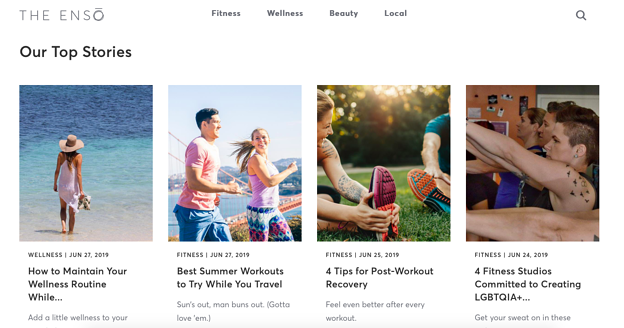
The blog is filled with content that taps into what its users are looking for: inspirational and motivational stories.
There’s no hard sell – just educational blog posts about different ways to stay healthy.
4. Optimise your on-page elements
You’re going to have a difficult time improving your online visibility if your on-page SEO isn’t on point.
A well-optimised web page will make it easier for Google’s search engine bots to understand what your website is about and rank it in relevant search results.
Slick websites are also a joy for your visitors to use, and a better user experience = more time on site, more conversions, and more sales.
There are a lot of different elements to on-page SEO. But at the very basic level, you should make sure to do the following:
- Encourage clickthroughs from search with a compelling meta title and meta description
- Add structured data to your website to enhance your listing in search results
- Incorporate your target keyword and related keywords into the heading, URL and body copy of your text
- Make sure your site loads quickly in line with Google’s new Core Web Vitals
- Ensure your website is optimised for mobile
- Replace any broken links or images on existing content
When you’ve checked off all your on-page SEO elements, you can move on to the other part of SEO: off-site SEO.
5. Build high-quality backlinks
Backlinks serve two important purposes.
First, they help build your website authority.
This is invaluable for SEO because Google’s algorithm considers a website’s authoritativeness when deciding which pages to rank at the top of search engine results.
Increase the number of high-quality backlinks to your website (i.e. links from reputable websites), and Google will see you as a trusted content source in your industry.
Eventually, this translates to higher rankings and, as a result, more traffic to your website.
But backlinks aren’t just a great way to improve your expertise, authority and trustworthiness.
They also bring more qualified traffic to your page.
Think about it. If your link is featured as a source or a recommended product, interested visitors will click on that link to learn more about your business.
Let’s take a look at this article talking about moisturising as part of your skincare routine:
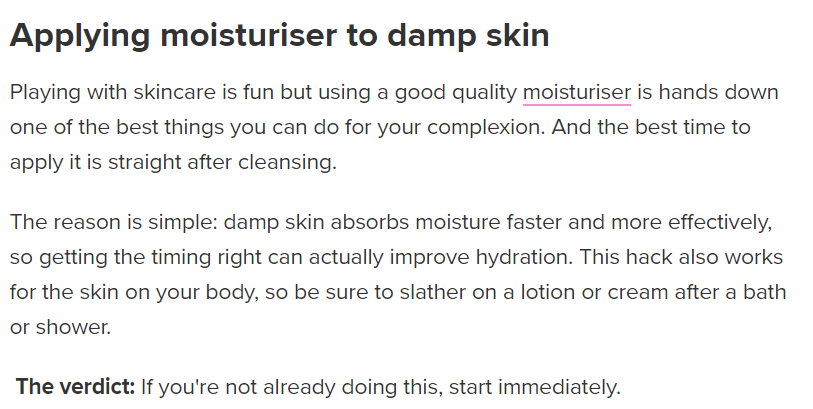
The link ‘moisturiser’ goes to a page promoting Nivea skincare products:
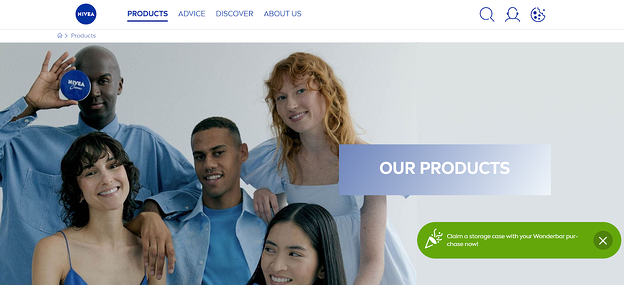
People who click on the ‘moisturiser’ link are already clearly interested in skincare products. In other words, the clicks going from that article to Nivea’s website are more likely to be qualified visitors who are ready to buy.
Bottom line: build up inbound links. With the right backlinks, you’ll be winning more visitors from Google AND from other websites that your target market uses.
6. Don’t forget about internal links
Inbound links are incredibly useful, but generating high-quality backlinks doesn’t happen overnight.
It takes careful planning and pitching — and most established websites have built up their backlink profile over YEARS of hard work.
In the meantime, there’s another simple action you can take to improve your website: internal linking.
Internal linking refers to linking one page on your website to another page on your website. This could be a link to another article or blog post, a product, an eBook or digital download, or a video.
With a well thought out internal linking structure, you’ll encourage existing visitors to stay on your website longer, visit more pages, and gain more value from your content. And these three are a surefire way to show Google that your website content is relevant to your visitors — which should lead to a nice little bump in your organic search rankings.
7. Track and analyse your SEO performance using SEO tools
Finding the winning formula for SEO doesn’t happen overnight.
You need to tweak your keywords, develop new content, optimise existing content, and continuously expand your backlink profile if you want to get more organic search traffic.
That’s where SEO tools make all the difference.
SEO tools help you identify the actions that are working for your website, where you’re currently ranking in search results, and the areas to focus your efforts on in the future.
Some tools even allow you to peek at competing websites to see what you need to do to come out on top.
There is no shortage of SEO tools out there, but these are five that we personally use at OMG:
Make a habit to review your SEO performance every month or quarter. Do this frequently, and you should start to move the needle on rankings and traffic.
8. Socialise online
The first rule of marketing?
Be where your customers are.
And where are your customers?
On social media platforms – well, for at least 2 hours and 27 minutes of every day anyway!
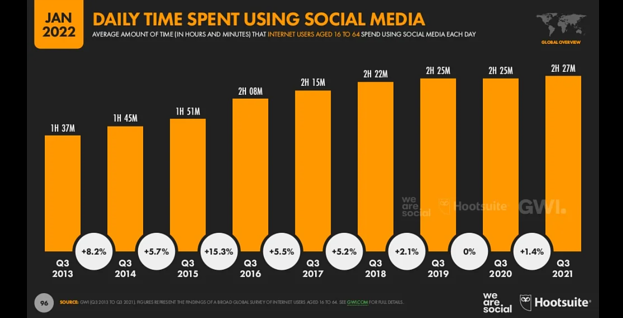
Source: We are Social
So, it should not come as a surprise that 76.1% of shoppers use social media for brand research.
That’s not to be sniffed at.
Especially when your social media audience consists of real people who want to engage with your brand.
So, how can you get a bigger slice of that traffic pie?
First, create content that your social media audience can relate to and ensure it all meshes with your brand’s message.
When Databox asked marketers which type of content was most effective on social media, 60% said video.
Social media management platform Buffer also found that the most successful content could be categorised as either inspirational, funny, or practical.
Like this one by US TV host, Jay Shetty:
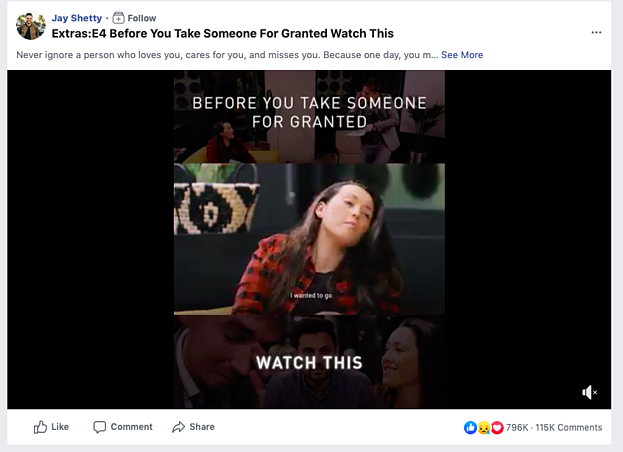
When was the last time one of your social posts got 115,000 comments?
Second, interact with your followers.
A stagnant social media page doesn’t do you any favours. People can see that you’re not responsive.
So what do they do?
They’ll find a page that actually answers their queries. Promote blog posts. Create content that speaks to them. Respond to queries. Be that page and you’ll get more traffic from social media.
Take a look at how this company, REC TEC Grills, gets it so right:
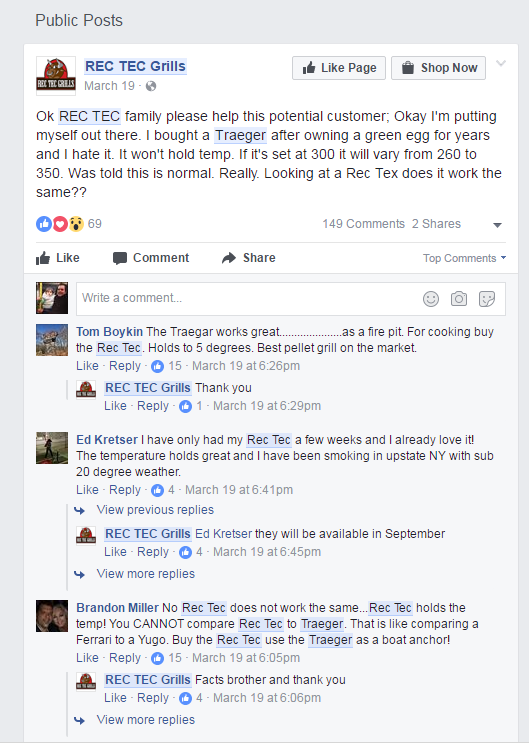
See how REC TEC leveraged the power of existing customers turning them into evangelists. (There were more than 100 comments after these top three!)
9. Use the right social media platform for your audience
Another tip for social media?
Give your users what they want.
Research shows 40% of users follow a Facebook page in order to receive a special offer.
So which platforms should you focus your efforts on?
It depends on your audience.
No doubt about it – as the world’s largest social media platform, Facebook is a brilliant place to engage your target audience. Not only does Facebook have over 2.9 billion users (making Facebook the largest country in the world, if it was a country), users spend an average of 19.6 hours per month on the platform.
For B2B, LinkedIn is your mothership.
The social network has a B2B focus and about 810 million members – where better to get in front of business customers?
Use the platform to build your brand’s authority in your niche. A better reputation means more shares and more organic traffic.
Data shows that 40% of B2B marketers say LinkedIn is the most effective channel for high-quality lead generation. Over 1 in 2 buyers also say LinkedIn content has the biggest influence on their decision during the research phase of the buyer’s journey.
10. Answer questions on Quora
Social media isn’t just limited to the classics like Facebook, LinkedIn, Instagram, and TikTok. In fact, online forums like Quora are great sources of organic traffic if you can provide valuable information to users.
Quora is an online Q&A platform where people ask and answer questions on different topics, from questions on remote work to psychology, self-improvement, and even online marketing.
Set up a profile on Quora and follow any topics that are relevant to your business or industry. If you see any questions that pop up, try to answer them as best you can.
Here’s a great example from a travel agent Far Far Away Travels:
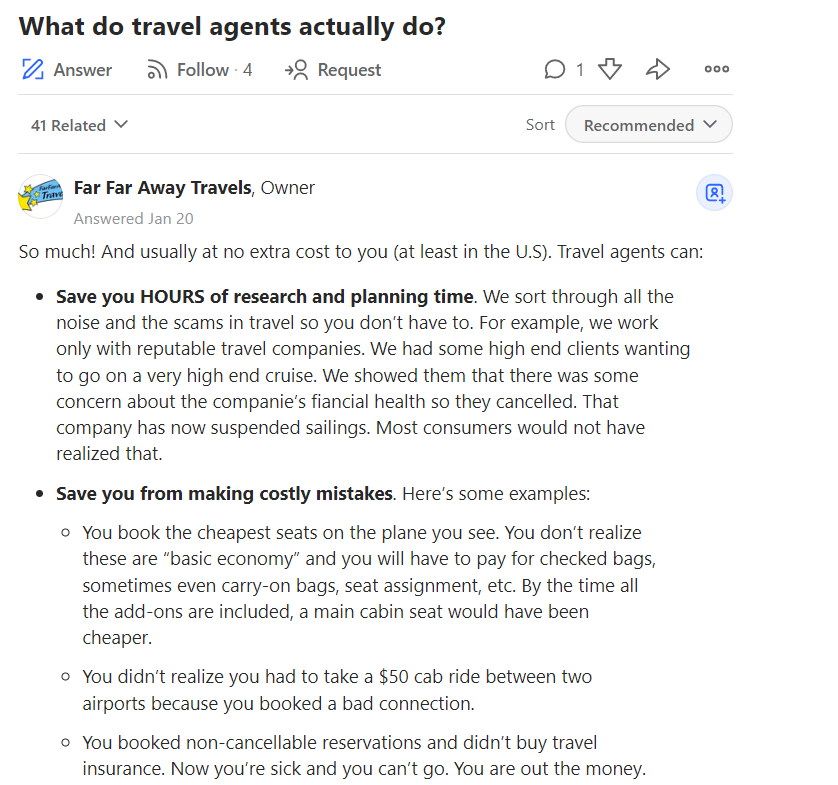
The key with Quora is to find the right questions and respond with thoughtful, well-researched answers.
To find the right questions, navigate to Ahrefs and pop the Quora URL into Site Explorer:
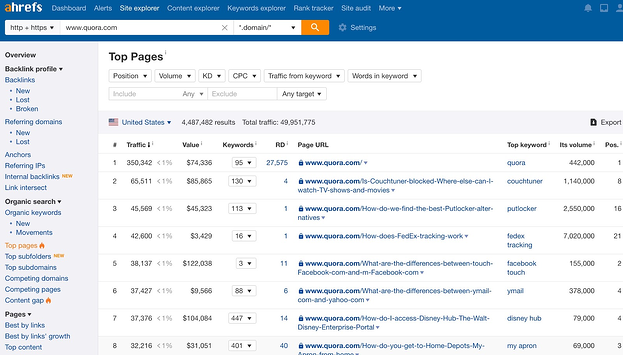
This will show you which questions are receiving the highest volume of traffic. You can then filter it to include certain keywords that are relevant to your business, like “renovations” or “plumbing”. Work your way gradually through this list, and be sure to check back regularly to find more questions as people ask them.
Once you do find relevant questions, you need to craft a compelling answer. Answers should be well-written and carefully researched, like this one by Si Quan Ong from Ahrefs:
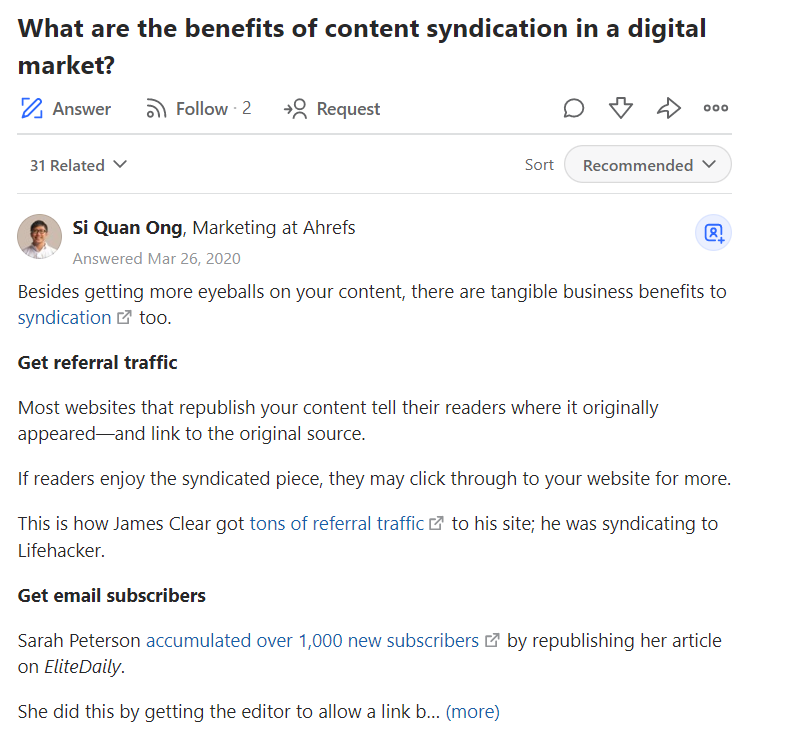
Quora also allows images in answers, so sprinkle a few of those in to keep your audience’s attention.
11. Leverage influencer marketing
Influencer marketing is still alive and kicking — and it’s one of the most effective ways to bring qualified referral traffic to your website.
According to research, roughly 1 in 2 consumers depend on influencer marketing for product recommendations. And some brands, like Gymshark, have built their entire online empire on the awareness and traffic generated from well-known online personalities:
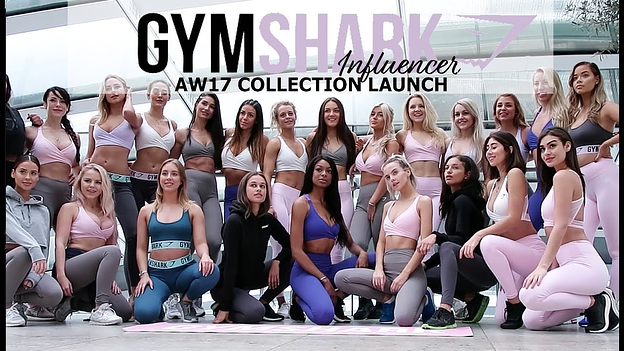
Image credit: Influencer Matchmaker
If that’s not enough, influencer marketing campaigns deliver outstanding ROI, with one report showing that brands earn $5.78 for every dollar invested in the campaign.
So how do you use relevant websites and influencers to spread the word about your business and bring traffic back to your page?
Here are some thought starters:
- Partner with them on an exclusive product or promotional campaign
- Provide products for review or to feature in sponsored posts
- Provide influencers with a dedicated promotional code for their social media followers
- Guest blogging on an influencer’s website or invite them to post on yours
Don’t forget about micro-influencers either.
While bigger influencers might charge a hefty sponsorship fee for their work, micro-influencers can be just as influential in terms of driving traffic to your website.
Just look at these numbers, which reveal that micro-influencer social media pages are often more engaged and likely to take actions like visiting the brand’s website:
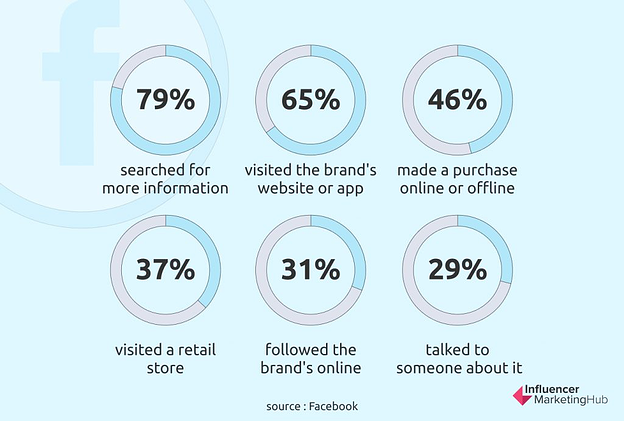
12. Participate in Facebook Group discussions
Most businesses only use Facebook to share posts or run ads.
While these should be the foundation of any successful Facebook strategy, there’s another element you should be using to drive traffic to your website.
That’s right – we’re talking about Facebook Groups.
More than 1.8 billion people use Facebook Groups every single month, which accounts for more than 64% of the social network’s total user base.
With Facebook Groups, you can build awareness for your business by helping your target audience.
There are two ways to leverage relevant online communities for your business.
The first is to respond to questions in existing Facebook Groups that are relevant to your product or service, like this question in The Content Marketing Lounge.
There’s no doubt that the original poster will check out all of the businesses recommended in the response — as will any future group members looking for something similar:
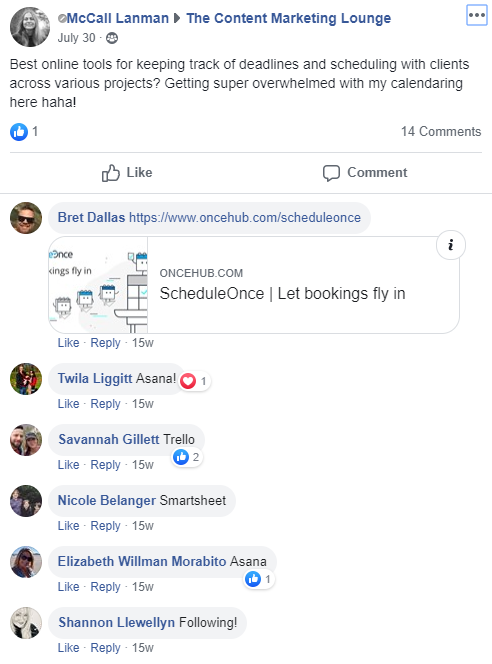
There’s no doubt that the original poster will check out all of the businesses recommended in the response — as will any future group members looking for something similar.
Alternatively, create your own group for members of your community like Peloton:
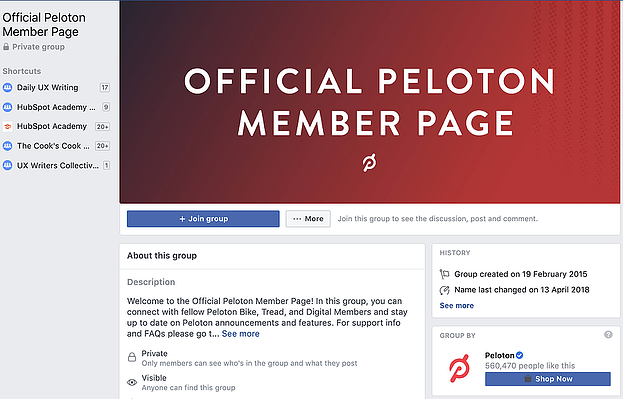
Image credit: Hubspot
This is a great place to share news, content and product updates amongst an already engaged audience.
13. Don’t forget about email marketing
The expansion of social media hasn’t been great for email’s reputation. Many people consider email marketing to be old news.
This is entirely wrong.
Email is still an exceptional way to increase organic traffic… so long as you use it correctly.
Consumers who buy products through email spend 138% more than those who receive email offers.
And if you’re reaching out to a B2B audience, it’s no contest: 59% of B2B marketers say email is their most effective channel in terms of generating revenue.
All in, for every $1 spent on email marketing $42 is made in return, says a study by DMA.
The challenge is, once you have a great email list filled with potential customers (thanks to your lead gen content), how do you make your email stand out?
Use these actionable tips to get more traffic:
Be clear on your goal.
Are you welcoming a new customer? Clawing back an old one? Or, are you going to talk about a new offer? Every email has its place.
A welcome email for a new subscriber or customer engages people with your brand and can increase site traffic. Welcome emails are incredibly effective, with on average 320% more revenue attributed to them on a per email basis than other promo emails.
Craft a compelling subject line.
Think about using an emoji. After all, 56% of the brands that use them report a higher open rate. Most importantly, make sure your subject actually tells the reader something useful. Nobody wants to click on an email with a spammy subject.
Here’s one we love from Krispy Kreme:

The subject immediately stands out in the inbox, with just enough mystery to make you want to click.
Then, you get this:
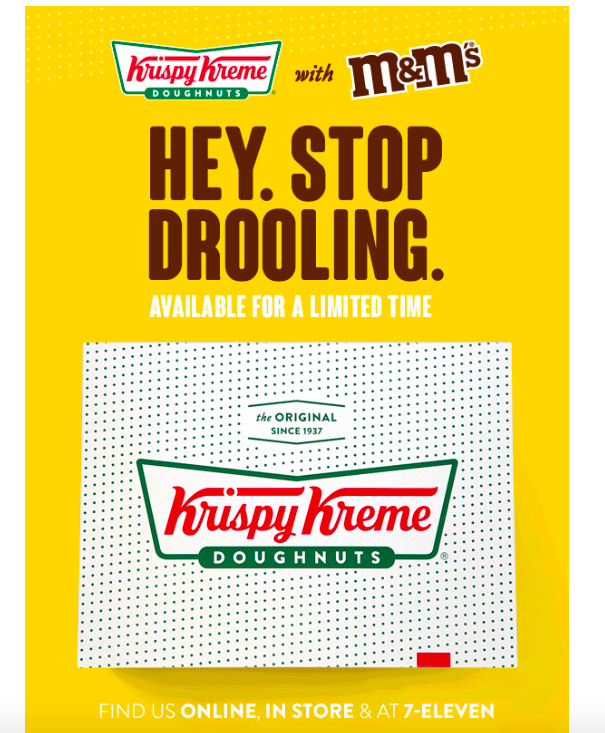
A dynamic email that reveals M&M doughnuts. Now, they’ve really got your attention!
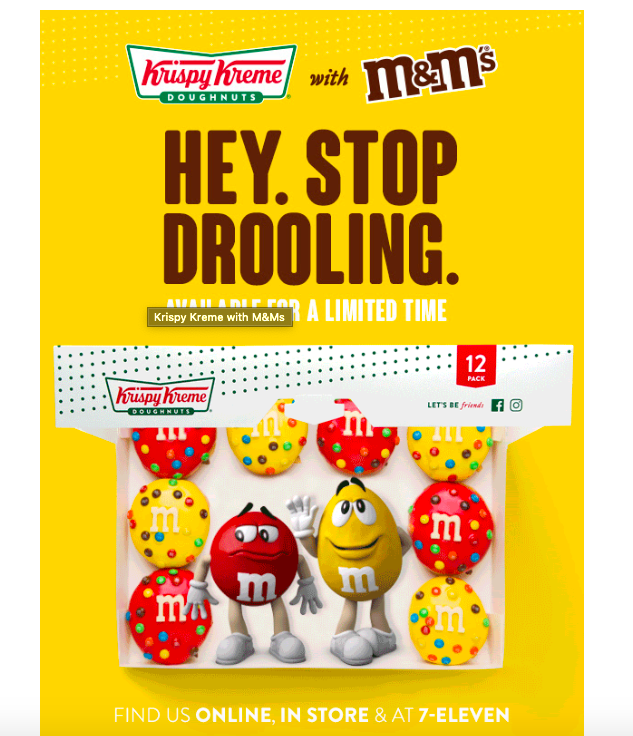
Make your call to action strong.
Your goal with email is almost always to drive traffic to your site to take the next action.
So, you need to make your call to action irresistible.
Like this one from the Headspace meditation app:
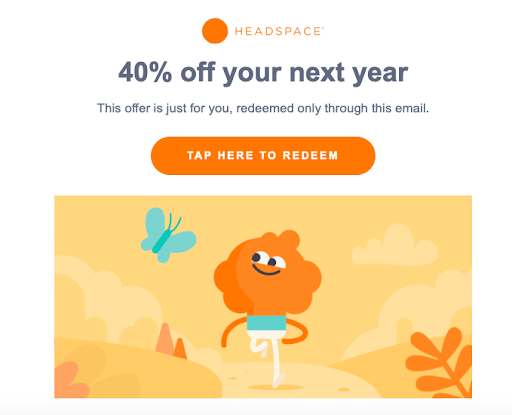
Or this one from Foxtel:

One thing to remember here is to always put your call to action near the top of the email (above the fold) and use a different colour to make it stand out so it’s the first thing readers see.
14. Drum up referral traffic with guest posts
Referral traffic comes from someone else’s website which has a link to yours.
Why should you care about referral traffic?
Because it gets your content in front of new, relevant audiences, opening the door for even better audience engagement and conversions that you wouldn’t otherwise get.
The problem is too many people try to buy referral traffic. They spend money on backlinks, but none of them send any useful traffic their way. Worse, this is a black-hat tactic and Google won’t let you get away with it.
Your content is the key to generating referral traffic.
Create unique, high-quality content that other people want to link to if you want to increase website traffic.
Show off your expertise and build your reputation as an authority. The more people trust you, the more likely they will link to you.
That’s how we do it here at OMG.
Our experts provide guest blog content to other relevant sites, like this one at Dot Digital:
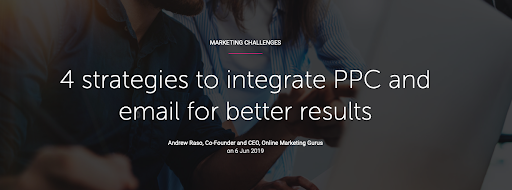
But even when you have a sweet link to a comprehensive blog post that is highly relevant to your brand, readers aren’t necessarily going to follow the link to your website.
Sometimes that link is just a nod to where they got the information – proving to the reader that they didn’t make up the statistic.
The reader doesn’t actually need to follow the link as they have everything they need in the article already.
So, to drive valuable referral traffic, the reader needs a compelling reason to click through to your site.
15. Build linkable resource lists
One of the best ways to generate traffic from referral links is when your link is in a list of resources.
Let’s say someone googles “best SEO audit tools” and finds a list from a reputable site near the top of the search engines:

They want to actually find a tool to use, so the intent is high. When they read about a tool they like, they’ll likely click through to the site.
In fact, they will probably click through to a few sites to compare tools.
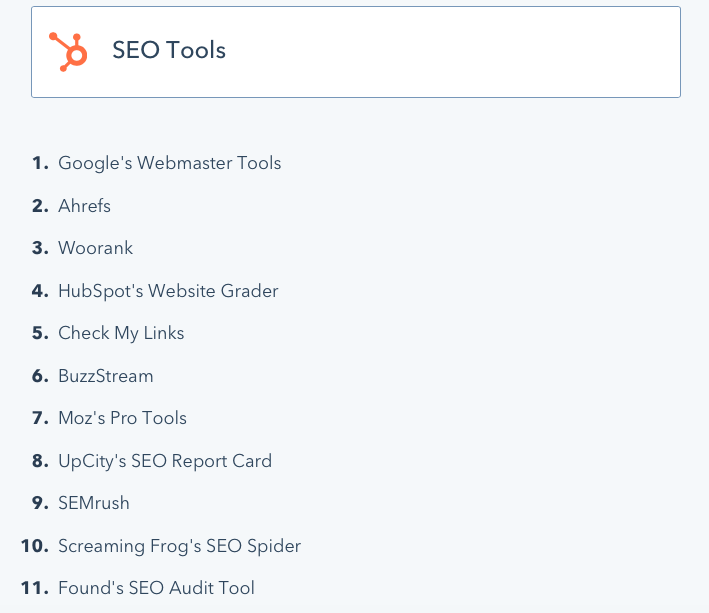
Now that’s qualified traffic you want.
How to get qualified paid traffic to your website
16. Get in front of your target audience with search ads
Pay-Per-Click advertising is exactly what it says.
You pay for ads by giving an advertising platform, such as Google Ads, money for each click of the ad. It’s effective too.
PPC catches people right at the point where they’re ready to buy.
They search and there you are with an attention-grabbing ad with a message and offer that matches their intent so closely, they can’t resist clicking through to your landing pages.
That’s not to say SEO isn’t needed, of course.
SEO helps you to reach an audience at a different stage of the sales funnel and prime them ready for purchase.
PPC, on the other hand, is ideal for converting customers who already know what they want. Target the right keywords and queries and you can generate high returns from your paid traffic.
Google estimates that businesses make an average of $2 in revenue for every $1 they spend on Google Ads.
But we think you can do even better than just average.
How?
By combining PPC and SEO.
That’s exactly what we did for a corporate gift card company and, within a year, the company’s lead count doubled.
Better yet, these were qualified leads, which meant an increase in actual conversions.
We smashed their target of 300% traffic increase, achieving an increase of 600% in just one year.
17. Integrate your PPC advertising across social media
Let’s start by talking a bit about social media advertising – specifically, Facebook advertising.
Facebook offers an extremely powerful PPC advertising platform.
Facebook Ads has the potential to reach more than 2.18 billion people. What’s more, Facebook reportedly generates the highest ROI amongst all paid advertising platforms.
But like all channels, Facebook advertising is at its most powerful when combined with other PPC tactics.
Let’s say you’re a sportswear brand having an end-of-season sale. A Facebook ad allows that sale to pop up in the news feeds of people who aren’t actively searching for sportswear right now. Some may go onto your site to browse, or even purchase, but everyone who sees the ad is now aware of your sale.
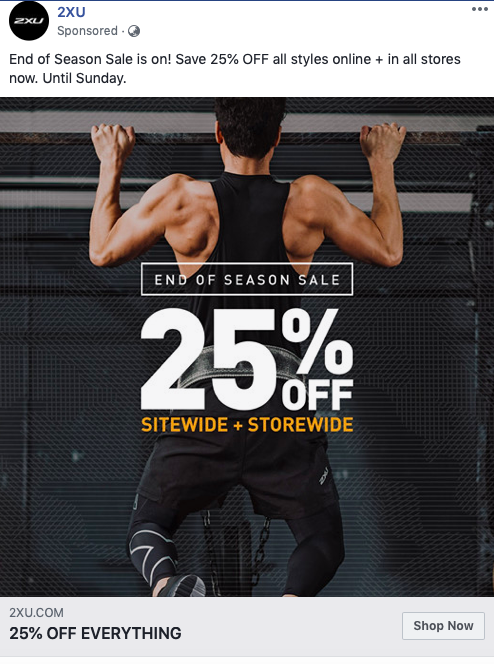
A day later, the Facebook user wants to find out more. They type your brand into a Google search, and there’s your PPC ad for the sale:
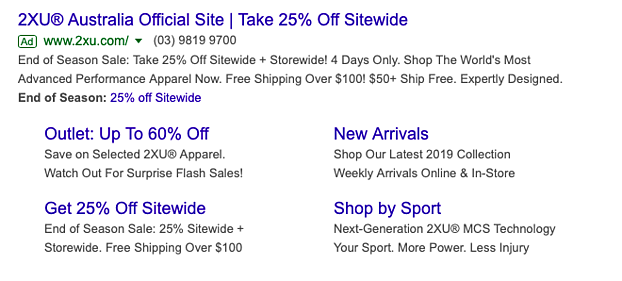
See how a combination of social media and search advertising can help you generate leads?
It’s powerful stuff.
18. Steal your competitor’s strategy
What’s the best source of information on the PPC campaigns that work best for your industry?
Your competitors, of course.
Competitor websites are a goldmine of information. They reveal the keywords that your competitors are bidding on, ad creative, ad spend, and more.
Luckily, you don’t have to send an undercover employee into your competitor’s office to figure out their secret formula.
Just hop into SpyFu and you can access all of this information for the past 15 years:
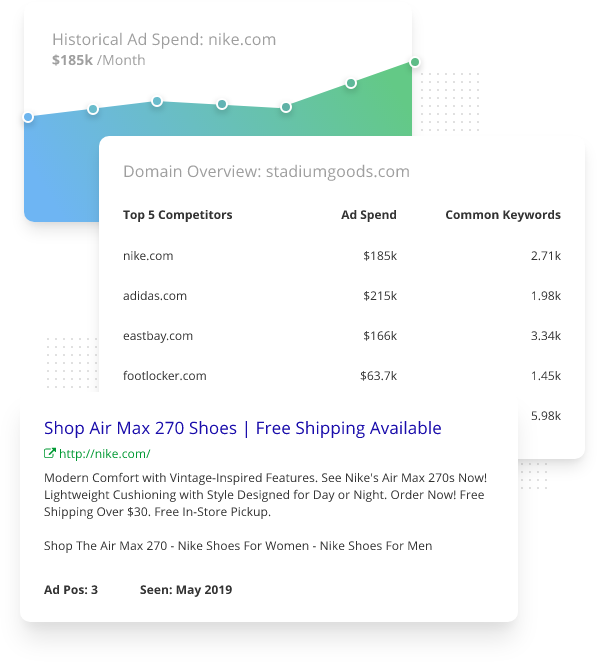
You can do the same thing for organic traffic.
All you need to do is plug your competitor’s website URL into free tools like SimilarWeb:
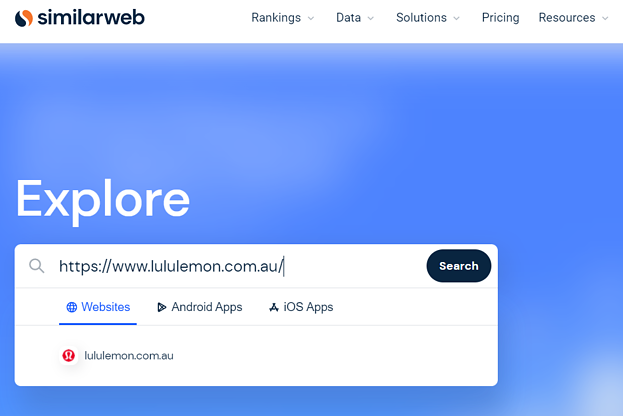
SimilarWeb will then show you their overall site traffic and their top referring sites:
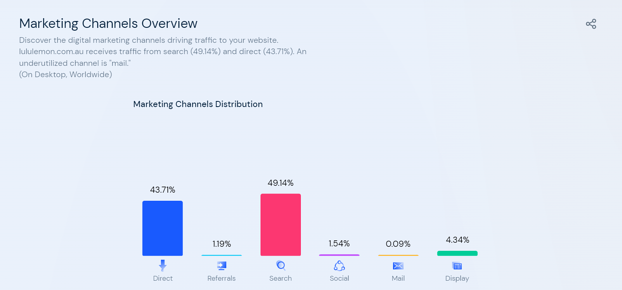
19. Use PPC ads to inform other marketing channels
PPC isn’t just handy for driving more qualified traffic to your website.
It’s also insanely helpful if you want to improve your traffic from your organic channels, such as email.
Test your calls to action, subject lines, copy, and offers in your pay-per-click ads BEFORE you use them in email campaigns.
For example, you can create two PPC ad campaigns – one with a subject line to ignite FOMO (fear of missing out), with words like ‘urgent’, ‘important’, or ‘limited offer’. And the other with a subject line that sparks their curiosity.
Then watch the Google Analytics data to see which one performs better, and use it for your next email campaign.
The Final Word
The right online marketing campaign boosts traffic and improves conversions. But if you get it wrong, you’re just throwing money at nothing.
You get no results and a hole in your wallet.
Whether you’re a business owner or seasoned marketer, these techniques are proven to help increase website traffic. And increasing website traffic is the first step to increasing sales and revenue.
But, as you’ve seen, it’s not just about cherry-picking the techniques and using them for one-off campaigns.
The best results come from combining their powers to reach your audience in lots of different places, with targeted messages that compel them to visit your site – and ultimately, convert.
So, how do you bring it all together? Download your FREE Digital Marketing Game Plan to find out.









